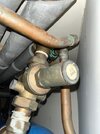OK lets try and concentrate on the slow cylinder, so shut down the fast cylinder, ie cold supply shut.
I would then ensure that the regulating gate valve on the slow cylinder HW outlet is fully open, ie, shut it, then open it fully, there should be 3 to 5 full turns of the hanwheel between fully shut and fully open, is there??.
Does the PRV set up and E.vessel look something like the attached, can you see what setting the PRV is set to, it may be faulty??, if you have a car tyre pressure gauge then checking the E.vessel airend may give a idea of the cylinder pressure, it should vary a little if you can achieve a flow from the cylinder.
View attachment 297583


